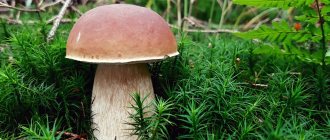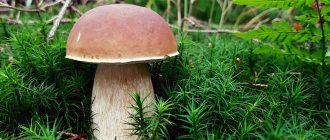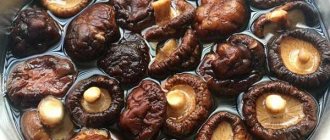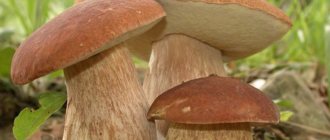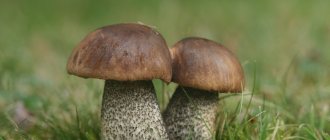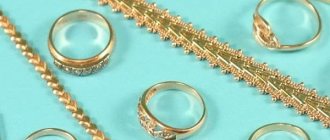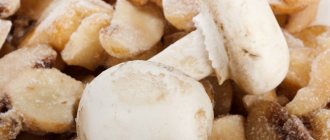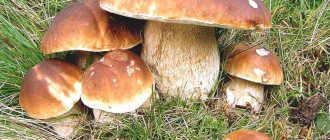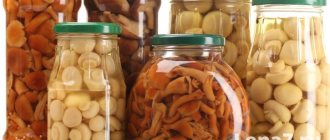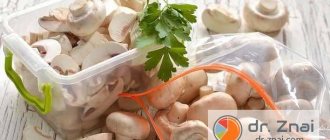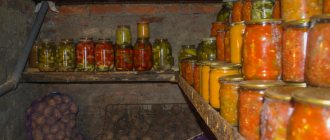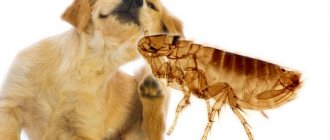Mushrooms
0
1340
Article rating
Kira Stoletova
The first priority after harvesting is processing the mushrooms. There is no need to delay the process, because the product quickly deteriorates. If it is not possible to process the crop immediately after arriving from the forest, you are allowed to postpone work for only a few hours. To properly prepare mushrooms for consumption, you need to learn certain rules.
Mushroom processing
Processing - the basic rules of a mushroom picker
First of all, the mushrooms need to be sorted out and cleared of debris, sand, and soil. Then they are sorted and defective specimens are thrown away. Damaged parts are cut out with a knife.
The peel, if it separates well, needs to be removed. The mushrooms are washed. Afterwards they are folded back to dry.
How to process wild mushrooms
First, the processing takes place in the forest; you can clean off the dirt while you are in it. Then the mushrooms should be cleaned. The covering film is removed from russula and boletus.
Boletuses and boletuses are cleared of needles, leaves, and branches. Hats are cut. Mushrooms are inspected for worminess. If there are holes, the copies are thrown away.
Then the mushrooms are washed. This should be done in cool water. Milk mushrooms and white mushrooms are soaked before cooking.
Cleaning and processing porcini mushrooms
Boletus mushrooms are cleaned immediately after collection. It's better to do it outside. Treatment includes cleaning of dirt and leaves.
The harvest can be stored for no more than 4 hours. You can keep it in the cellar or refrigerator for a couple of days. Otherwise, the mushrooms will lose their flavor.
Processing mushrooms after harvesting
Mushrooms are exposed to high temperatures to completely or partially eliminate their toxicity, bitter taste or unpleasant odor. It should be remembered that such processing impairs the nutritional quality of the mushrooms, as well as weakens their aroma and taste. Therefore, if possible, it is better not to cook mushrooms at all, but to fry them in their natural, fresh form. This is quite possible with chanterelles, boletus, champignons, saffron milk caps, summer honey mushrooms and young autumn ones, as well as many rows and russula. Let's say even more: some varieties of mushrooms acquire viscosity after boiling. This happens, for example, with caps, chanterelles, as well as the legs of boletus and boletus. It’s worth knowing about these features when preparing mushroom dishes.
But with some mushrooms you can’t do without cooking. You have to sacrifice nutritional value to dissolve harmful substances in the water. These mushrooms include: trumpet mushrooms (pink and white), some russula (brittle and stinging), common lines, milk mushrooms (black and yellow). They need to be boiled for about 15-30 minutes, and then be sure to pour out the broth. The bitter taste of some mushrooms (moths, milkweeds, milk mushrooms, milk mushrooms, bitter mushrooms, violin mushrooms, as well as some talkers and russula) is removed by short cooking (5-15 minutes is enough). But it’s generally useless to cook the gall mushroom - the bitterness will never go away.
Stage one is the primary processing of mushrooms. Consists of several sequential steps:
1) Sort. Different types of mushrooms differ not only in taste, but also in cooking technology. Therefore, pre-sorting will not hurt at all. For example, you can separate mushrooms that need to be boiled from those that can be thrown into the pan fresh. To make it easier to process the mushrooms, it is recommended to arrange them into piles, depending on their size.
2) Clear away debris. Along with the mushrooms, we bring from the forest leaves, pine needles, pieces of moss and twigs that have stuck to the caps and legs. All this inedible debris, of course, needs to be removed - scraped off with a kitchen knife or gently cleaned with a clean cloth. You should be especially careful with mushrooms that are planned to be dried for the winter. Here you can clean the entire surface of the mushroom with a brush without missing a single wrinkle.
3) Peel with a knife. Some parts of the mushroom are definitely not suitable for food. They must be carefully cut with a knife so as not to risk your health. These are, for example, all softened, damaged or darkened areas. If the mushroom is old, then the inside of the cap should be removed. It is recommended to cut off the stem of some mushrooms so that the dish does not turn out sticky. And the cap of late butter and russula is cleaned - there the skin becomes slimy and bitter during the cooking process.
4) Rinse with running water. The time for washing mushrooms should be short so as not to spoil the taste of this product. If you plan to fry the mushrooms, then just rinse them with cold water. Mushrooms for drying are not washed at all. All other processing methods require a quick wash in cold water and draining in a colander to drain excess liquid. For these purposes, by the way, a sieve or flat board without grooves or depressions is also suitable. Some mushrooms have an uneven surface; dust and sand often collect in their folds. These are hedgehogs, stitches, morels and some others. Naturally, these types need to be washed a little longer to remove all the debris. True, experts say that you still can’t completely get rid of sand with plain water, and they recommend boiling the mushrooms in boiling water for five minutes, and then draining the water and rinsing in a colander.
5) Soak. This is done in order to remove bitter or salty notes from the mushrooms in taste. In this case, it is recommended to change the water once an hour so that harmful substances leave faster. Soaking also helps restore dried mushrooms to their original moisture. This water can be used as a base for mushroom broth.
Mechanical restoration
After harvesting, mushrooms such as oyster mushrooms should be processed immediately. If this is not possible, you can wait a couple of hours. Proper preparation includes following a number of rules.
Sorting
Regardless of the chosen type of preparation, mushrooms should be sorted (noble or not, edible/conditionally edible). For the preparation you will need to take medium-sized ones. Some mushrooms can be fried immediately, others require boiling (bull, goat, etc.).
Cleaning
You should get rid of insects and debris. A cloth is used for this. You can also process fruiting bodies with a knife. However, this is not a prerequisite.
Rules for adding salt
Not all housewives know that mushrooms have a very delicate relationship with salt. When adding salt, it is very important not to overdo it.
When frying, spices can be added immediately, salt - at the end (Photo: Pixabay.com)
Why is this so? Everything is simple here: salt draws out moisture, which is abundant in mushrooms. If you add salt at the beginning of cooking, the mushrooms will not fry, but will cook in their own juice. Therefore, it is best to salt them at the end of cooking.
Methods for harvesting and processing mushrooms
The product spoils quickly. That is why it is not stored raw. It is better to process mushrooms on the same day they were collected.
Drying and drying porcini mushrooms
An excellent harvesting method is drying. The dried product retains excellent taste. During the drying and drying process, approximately 90% of the mass dries out, but the mushrooms become more aromatic.
The drying rules are as follows:
- The highest quality specimens should be selected.
- Mushrooms cannot be washed; they are cleaned with a cloth.
- Large specimens are cut into several parts.
- The lower part of the leg is cut off.
Drying mushrooms
If the product is soft, you need to dry it like this: put the mushrooms in glass jars along with garlic and pepper. Top them with olive oil.
The lids of the jars must be tightly closed. The jars need to be sent for pasteurization. They are placed in a pan with a towel previously placed on its bottom.
Fill the pan 3⁄4 full with water. Then it is put on low heat. After bringing to a boil, pasteurize the jars for 25 minutes.
Hot jars should be placed on a wooden tray. It's worth waiting until they cool down. Store dried mushrooms in the pantry.
Oven drying
To begin with, it is worth dividing the mushrooms by type and size (champignons, boletus, etc.). Then you need to prepare a baking sheet. It is sprinkled with a little oil.
The baking tray is covered with baking paper. Mushrooms are laid out. Their caps should be directed upward, and there should be 1 mm between each specimen.
The need for high temperatures
One of the mistakes when cooking mushrooms is low cooking temperatures. This problem is especially relevant if you choose the wrong dishes.
Thus, it is advisable to cook mushrooms in a container with thick walls, for example, in a cast iron kitchen pan. This product heats up quickly and retains heat for a long time. If you use other cookware when adding cold mushrooms, the temperature may drop sharply, which will result in disruption of the cooking process.
Mushrooms are best fried in cast iron (Photo: Pixabay.com)
To make the mushrooms tasty and appetizing, you only need to place them in a hot frying pan and fry for 2-3 minutes, stirring occasionally. If the mushrooms brown too quickly, simply reduce the heat.
How to clean porcini mushrooms before freezing
Mushrooms must be peeled before freezing. Then the cut located on the stem is renewed, and the skin should also be removed from it. If the specimens are large, they are cut.
Preparation
There is no need to wash porcini mushrooms. Cut them into small cubes. Then they can be boiled or fried for 12 minutes.
How to clean the cap of a porcini mushroom
The dry cap is easy to clean. Wet mushrooms should be wiped with a cloth. You can also use an old toothbrush.
Do I need to peel the stem of porcini mushrooms?
This should be done without fail. Moss, foliage, and needles need to be removed. If worms are visible, this part of the leg will have to be cut out.
Possible problems and ways to solve them
Even experienced mushroom pickers can confuse good specimens with poisonous ones. Boletus mushroom and gall mushroom are especially often confused. The latter differs in cut.
Boletus does not change its color even after marinating and cooking.
Another problem is spoiled adult mushrooms. If you find one, it is better to throw it away immediately. Old mushrooms are not only not healthy, but also tasteless.
Mushrooms need oxygen
You can often see that some owners store mushrooms in a tightly closed container or bag. But this storage method is not suitable for mushrooms. The fact is that this delicate product, when stored in a closed container, becomes covered with mucus and wrinkles. This not only makes it less aesthetically pleasing in appearance, but also negatively affects the taste.
If you want this product to retain its taste and aroma, you should store the mushrooms in the refrigerator in paper bags. To prevent them from drying out, cover the top with a damp paper towel.
In addition, you should not wash them before storing - all preparatory procedures are carried out before the actual preparation of food.
Seasonings and additives
Mushrooms have a rich natural taste and aroma. During heat treatment, some of them lose these properties. Properly selected seasonings will help restore the lost taste and make it even brighter. The following spices are most suitable for the product :
- fresh and dried herbs (dill, green onions and parsley);
- garlic;
- Mediterranean herbs (thyme, rosemary, oregano);
- nutmeg.
Parsley, dill and onions have a pleasant aroma and are an excellent addition to mushroom dishes. Garlic is considered the leader among spices. With it, any dish acquires a special taste.
Mediterranean herbs lightly refresh the dish and add a spicy aroma. They are best added to soups.
Nutmeg has a strong flavor. A little young nutmeg is added to long-cooking dishes.
Cleaning mushrooms in the forest
It's no secret that mushrooms hide under leaves or fallen pine needles. Wet weather that persists during rains promotes strong adhesion of small debris to the caps and legs. Before you send the forest gift you like to the basket, you need to clear it of twigs and leaves. Then we have less work waiting for us at home to wash the hats. Sticky leaves and needles can be scraped off with a knife. If the mushroom has wormholes, they need to be cut off until dense pulp without holes appears. You can cut the mushroom in half to make sure there are no worms. We will carry out more thorough cleaning at home.
To make sure there are no worms, the mushroom can be cut in half
How to properly process a poplar row
For many mushroom pickers, poplar rows are considered popular. This is a conditionally edible mushroom, popularly called poplar. These fruiting bodies grow near or directly below poplar trees in large rows. These mushrooms are usually always very dirty, so let's look at the information on how to properly process a poplar row.
- The first step, which will tell you how to process rows, is soaking in cold water for 3 days. In this case, you need to change the water 2 or 3 times daily. Thanks to this approach, all the bitterness is removed from the mushrooms and the dirt is soaked away. Note that if the temperature of the water for soaking mushrooms is above +16°C, this is bad, since the fruiting bodies can ferment. Therefore, change the water more often to protect the mushroom crop from spoilage.
- The rows are boiled in water with added salt for 30 minutes.
- Drain the mushroom broth, rinse in running water and allow to drain.
The most delicious dishes with mushrooms
Mushrooms are great both for preparing sauce for dishes and as an independent product on the dinner table. Use our recipes to surprise your family!
Mushroom sauce for beef steak
You will need : 200 g of boiled wild mushrooms (preferably boletus), 2 cloves of garlic, onion, 200 ml of heavy cream, salt and pepper to taste.
Cooking . After chopping the onion and garlic, fry in butter for 5-7 minutes. Then add the boiled mushrooms and simmer for another 10 minutes, add salt, pepper and cream. Keep on low heat until the cream boils. Then remove from heat and serve with meat.
Mushroom casserole with pasta
You will need : 500 g of wild mushrooms, 500 g of pasta, 1 onion, 200 g of cheese, 50 g of butter, 300 g of sour cream, a bunch of parsley, salt and pepper to taste.
Cooking . Boil the pasta, drain the water, then mix it with the butter. While the pasta is soaking in oil, fry the mushrooms with chopped herbs in a frying pan, salt and pepper them.
Place half of the pasta in a baking dish and pour sour cream over it. Place half the mushrooms on top and sprinkle with some grated cheese. Place the remaining pasta on top, add sour cream again and add mushrooms. Finally, sprinkle with grated cheese. Bake the dish for 20 minutes until a crust forms.
Mushroom soup
You will need : 400 g potatoes, 1 carrot, 200 g boiled mushrooms, bay leaf, peppercorns, 2 onions, parsley, salt to taste.
Cooking . Peel the potatoes and carrots and cut them as desired. Place the vegetables in a pan of boiling water and add salt. After 10 minutes, place the mushrooms in the pan. Peel the onion, chop and simmer together with finely chopped parsley in a frying pan, adding a little water.
Place the stewed spices with the other ingredients, add the bay leaf and peppercorns and cook everything together for another 10 minutes.
In this article, you learned how to properly cook and prepare mushrooms, and also learned about recipe options for mushroom dishes. Share your secrets with us!
Add fat when frying
Many housewives try to use as much oil as possible when frying, believing that the product lacks fat. Such anxiety does exist.
Indeed, at some point during cooking, the mushrooms may actually be starved of oil. This does not depend on the number of stirrings, as many people think, but on the spongy structure of the mushrooms.
If you want to speed up the process without damaging the texture and color of the mushrooms, simply drizzle a little oil or fat into the pan periodically.
Pickling
Most often, tubular types that do not contain bitterness are pickled. Small mushrooms are marinated separately, and large ones should be cut into pieces. The legs need to be separated from the caps, and they can be marinated either together or separately. Mushroom pickers advise selecting the caps and using the stems for preparing other dishes.
If the boletus is young, it is necessary to remove the lower film. It is more convenient to do this with the tip of a thin knife. The stem should be left a couple of centimeters from the cap.
Those mushrooms that will be pickled cannot be washed, as they will absorb water, which is extremely undesirable. It is better to wipe them with a damp cloth.
